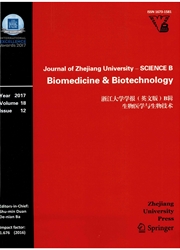

 中文摘要:
中文摘要:
在优核质, Mre11-Rad50-Nbs1 (MRN ) 建筑群,住在发信号的 DNA 修理和检查点的十字路口,很快在跟随双海滨裂缝(DSB ) 正式就职的损坏地点形成突出的 foci。这建筑群执行 DSB 结束的起始的处理。在编码这建筑群的部件的基因的变化导致 DNA 损坏超敏性, genomic 不稳定性,弄短的 telomere,和异常成熟分裂。因此, MR 蛋白质高度在进化期间被保存。Mre11 和 Rad50 的细菌的 orthologs 分别地是 SbcD 和 SbcC 蛋白质。Deinococcus radiodurans,一极其无线电抵抗细菌,能修理几百导致放射的 DSB。SbcD 和 SbcC 蛋白质作为 Dr1921 和 Dr1922 基因的产品被识别。由直接反向取向的 insertional 傻瓜发育不全技术, sbcD 基因的混乱显著地增加房间“敏感到损坏代理人的 DNA 的各种各样的类型,例如电离放射,极端 iolet 照耀,氢过氧化物,和 mitomycin C。我们也提供 drSbcD 蛋白质在这个有机体在生长和 DNA 修理起一个重要作用的证据,特别在在到红外的 6000Gy 的细胞的暴露以后产生的 DSB 的修理。这些结果证明 drSbcD 蛋白质在 D 在 DSB 修理起一个重要作用。radiodurans。
 英文摘要:
英文摘要:
In eukaryotes, the Mre11-Rad50-Nbs1 (MRN) complex, which resides at the crossroads of DNA repair and checkpoint signaling, rapidly forms prominent foci at damage sites following double-strand break (DSB) induction. This complex carries out the initial processing of the DSB ends. Mutations in the genes that encode components of this complex result in DNA-damage hypersensitivity, genomic instability, telomere shortening, and aberrant meiosis. Therefore, the MR proteins are highly conserved during evolution. The bacterial orthologs of Mre11 and Rad50 are the SbcD and SbcC proteins, respectively. Deinococcus radiodurans, an extremely radioresistant bacterium, is able tO mend hundreds of radiation-induced DSBs. The SbcD and SbcC proteins were identified as the products of the Dr1921 and Dr1922 genes. Disruption of the sbcD gene, by direct reverse-orientation insertional mutagenesis technology, remarkably increases the cells' sensitivity to various types of DNA damaging agents, such as ionizing radiation, ultraviolet irradiation, hydrogen peroxide, and mitomycin C. We also provide evidence that the drSbcD protein plays an important role in both growth and DNA repair in this organism, especially in repair of DSBs generated after cellular exposure to 6000 Gy of IR. These results demonstrate that the drSbcD protein plays an important role in DSBs repair in Do radiodurans.
 同期刊论文项目
同期刊论文项目
 同项目期刊论文
同项目期刊论文
 Internal promoter characterization and expression of the Deinococcus radiodurans pprI-folP gene clus
Internal promoter characterization and expression of the Deinococcus radiodurans pprI-folP gene clus Deinococcus radiodurans PprI switches on DNA damage-response and cellular survival networks after ra
Deinococcus radiodurans PprI switches on DNA damage-response and cellular survival networks after ra Evaluation of the antioxidant effects of carotenoids from Deinococcus radiodurans through targeted m
Evaluation of the antioxidant effects of carotenoids from Deinococcus radiodurans through targeted m DrRRA: a novel response regulator essential for the extreme radioresistance of Deinococcus radiodura
DrRRA: a novel response regulator essential for the extreme radioresistance of Deinococcus radiodura A Novel OxyR Sensor and Regulator of Hydrogen Peroxide Stress with One Cysteine Residue in Deinococc
A Novel OxyR Sensor and Regulator of Hydrogen Peroxide Stress with One Cysteine Residue in Deinococc Construction of DNA damage response gene pprI function- deficient and function-com- plementary mutan
Construction of DNA damage response gene pprI function- deficient and function-com- plementary mutan Identification and functional analysis of a phytoene desaturase gene from the extremely radioresista
Identification and functional analysis of a phytoene desaturase gene from the extremely radioresista 期刊信息
期刊信息
